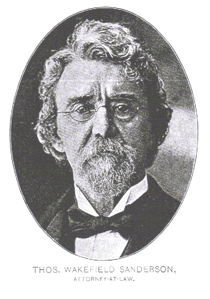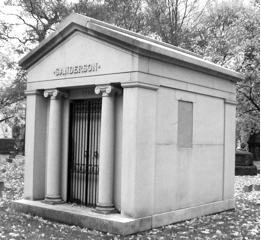(1829 – 1908)

There are no bronze monuments of Civil War General Sanderson in any of Youngstown’s parks. There are no paintings of him astride his horse leading one of his cavalry charges against the Confederates. None of the historical societies have records of his brilliant military career. It is as if General Thomas Wakefield Sanderson never existed. His life as an outstanding lawyer, citizen, soldier and author have faded from memory and what remains today are a few pages in one or two library books plus his obituary on microfilm. General Sanderson was laid to rest in the Oak Hill Cemetery almost one hundred years ago. He left no descendants to tell his story but this issue will bring you the first of a two part series devoted to this man whose ability knew no bounds.
Gen. Thos. Sanderson
Part One – Sanderson’s Military Career
In 1836, at the age of seven Thomas Sanderson came to Youngstown with his parents from Indiana, Pennsylvania. He attended college and while there was urged by of his friends to prepare for the legal profession. At the age of twenty-three he was admitted to the bar and practiced law for the next nine years. When the Civil War started Attorney Sanderson gave up his practice and on September 12, 1861 he enlisted with the Second Ohio Volunteer Cavalry. He was given the rank of first lieutenant and assigned as regimental adjutant. One month later he was promoted to captain in Company K and served as assistant adjutant general in Doubleday’s Cavalry Brigade. Fourteen months later Governor David Tod appointed Sanderson to major in the Tenth Ohio Cavalry. He continued to rise through several promotions to that of Brigadier General in 1864. He was with General Rosecrans and participated in nearly all the battles of the Army of the Cumberland from Franklin, Tennessee to Atlanta. Georgia.
General Sanderson was with Sherman on his march to the sea. It was the cavalry that was the eyes of Sherman’s Army and Sanderson played a large part in keeping Sherman informed as to the whereabouts of the enemy. At Bear Creek Station, south of Atlanta, Sanderson lead a brigade of cavalry against three divisions of the enemy behind formidable barricades. With sabers drawn the Tenth Ohio Cavalry secured a dashing victory and for his gallantry in action Thomas Sanderson was made Brigadier General. He continued following Sherman from Savannah up through the Carolinas until the end of the war. After serving over 4 years, Gen. Sanderson was finally mustered out at Lexington, NC, on July 24, 1865. He then returned to Youngstown to again practice law.
The Tenth Ohio Cavalry was equipped and ready for action in the spring of 1862 and marched to Murfreesboro, Tennessee in time to perform picket and scout-duty until the Army of the Cumberland opened its campaign against General Bragg. The Tenth followed Sherman’s march to the sea, protecting the entire rear so completely from the Confederate’s numerous attacks that not a single wagon fell into the enemy hands.
Part Two – Sanderson’s Notable Career

The Sanderson Mausoleum
Oak Hill Cemetery – Lot 122
The Youngstown Daily Vindicator had a lengthy obituary in its Monday, January 27, 1908 edition. It started with, “Gallant Soldier Answered Taps Sunday Afternoon.” Then it went on to say that the General passed away from complications of diseases at 3:30 at his residence, 156 West Rayen Avenue, at the age of 78. “It is not unusual for an individual to achieve greatness along a certain line,” the Vindicator wrote, “but when a man exerts his energies in several fields, in each of which he gets for himself unusual and remarkable results, then his career is regarded as extraordinary.”
At the time of Gen. Sanderson’s funeral the Justice Courts were all closed out of respect for the president and oldest member of Bar Association. At the funeral many judges and lawyers spoke of their admiration and respect for the life and work of Gen. Thomas W. Sanderson.
Thomas Wakefield Sanderson was born on October 17, 1829. His father was a farmer and his mother’s family came from the town of Wakefield, England, the scene of Oliver Goldsmith’s tale of The Vicar of Wakefield. He entered college at Bardstown, Kentucky and prepared himself for the profession of law. In 1852, when scarcely twenty-three years of age, Thomas was admitted to the bar by the District Court at Canfield, then the county seat of Mahoning County. While he was studying law, he practiced civil engineering and continued this profession for two years after being becoming a lawyer. At the age of 28, Sanderson married Elizabeth Shoemaker of New Castle, PA., became mayor of Youngstown, filling out the unexpired term of William Rice, and was elected to the office of prosecuting attorney of Mahoning County. Mr. Sanderson had attained a large clientage and an enviable reputation at the bar before entering the Civil War. In 1862, he was 33 years old; an old age for enlistees.
Upon returning to Youngstown after his Army career, Gen. Sanderson was elected the first solicitor of Youngstown and served four terms. He was always interested in the success of the Republican Party and served as a delegate at large for the State of Ohio to the Republican convention that nominated General Grant for re-election as President in 1872. Mr. Sanderson was once considered for the U.S. Supreme Court, however, the previous three judges appointed to the bench had been from Ohio and President Harrison regretted his inability to make a fourth.
Gen. Sanderson’s obituary states, “His practice was very large and for many years he was considered the best trial lawyer in the state. He was a man who possessed quick perceptions and enjoyed more than the average success.” One of Sanderson’s most celebrated cases involved defending C.H. Andrews against the Hocking Valley Railroad. The suit was brought by the railroad to recover 15 million dollars. Three judges rendered a judgment for the defendant, which was a big victory for Mr. Sanderson. The case involved the largest amount of money ever claimed in the State of Ohio at that time.
The General’s many talents included writing. One year before his death he compiled and edited a 900 page book on the history of Youngstown and Mahoning County. It included lengthy biographies and photographs of 300 local citizens living at the beginning of the 20th Century.
Thomas and Elizabeth Sanderson had two children, a son and daughter. The son died in infancy but their daughter, Louise, became one of the most highly educated and accomplished young ladies in Ohio. When she died in 1901, it was a very hard blow to her parents.
